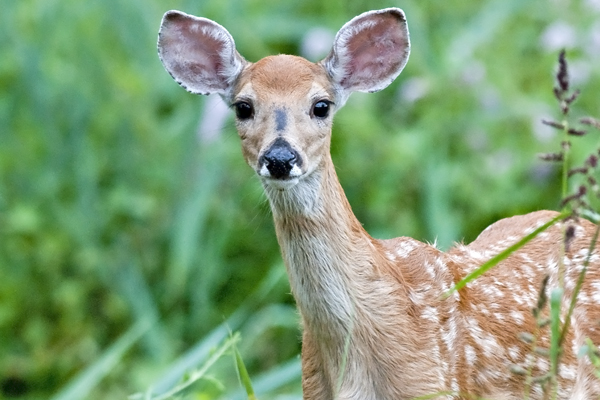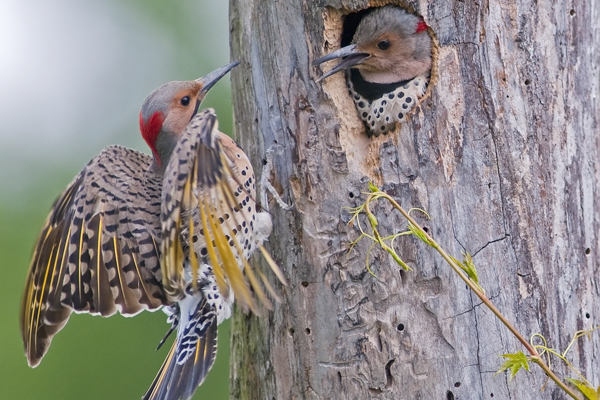 Experience nature without leaving the city
Experience nature without leaving the city
by Bernard Brown
Looking for some nature with your Philadelphia this summer? Want to go hiking without getting in a car? Well, it’s your lucky day—our gritty, urban paradise offers more than just concrete underfoot. Here are six ideas for places to get out, see wildlife—no, not rats and pigeons—and forget, for a moment, that you live in a major American city.

The John Heinz National Wildlife Refuge is most famous as a prime spot for urban birding—the website (fws.gov.heinz) lists about 280 species that frequent the refuge, including bald eagles (see sidebar)—so bring your binoculars. You can also bring your bicycle, fishing rod or canoe, but consult the website for fishing information and details on where and when you can hit the water; you wouldn’t want to get stranded on a mud flat at low tide. While walking the boardwalk, you might see enormous snapping turtles crawl out of the mud or water snakes cruising the reeds for frogs. Deer and rabbits are easy to spot in the woods, especially early in the morning or towards dusk. The Cusano Environmental Education Center exhibits offer a great introduction to the marsh, and you can join one of the free guided walks for a more personal experience. Call the Center to learn about the current offerings. 8601 Lindbergh Boulevard, Philadelphia, 215-365-3118.

If you’re interested in a spooky, near post-apocalyptic nature experience, check out the Mount Moriah Cemetery, which straddles Southwest Philly and Yeadon. Philadelphia is home to several large, scenic cemeteries—Mt. Laurel and the Woodlands are two of the nicer ones—but neglect a bucolic, historic cemetery for a few years and you end up with something wild. The tops of gravestones peek over tall, waving grass (Betsy Ross is back there somewhere), small trees knock grave markers over a quarter-inch each year and feral flowers swarm stone obelisks. I’ve seen foxes, groundhogs, raccoons and a whole host of small snakes and salamanders, along with a wide range of birds. Be warned that the cemetery sometimes hosts illegal, unsavory activities, especially after dark. There have also been warnings about wild dogs. I was chased out of a section by angry pit bulls—but that only happened once. 6201 Kingsessing Avenue, Philadelphia, 215-729-1295.

You can’t discuss hiking in Philly without raving about the Wissahickon Valley. This seven-mile stretch of Fairmount Park runs on both sides of the eponymous creek, from Ridge Avenue at the eastern edge of Manayunk out to the border with Montgomery County. You can bike or walk along Forbidden Drive at the bottom of the valley, but I prefer to hike the rocky trails that weave throughout the woods. Horses and mountain bikes are even welcome on designated sections of trail. If you get overwhelmed by all the wildlife (the Wissahickon is an Audubon Important Bird Area), stop for lunch at the Valley Green Inn, or admire some of the old stone walls and guardhouses built by the WPA (Works Progress Administration). There are numerous trail heads, but the Treehouse Environmental Center on the northwest end is a great place to start. 300 Northwestern Avenue, Philadelphia, 215-685-9285

Pennypack Creek runs for nine miles across Northeast Philly, from Fox Chase Farm—an educational agricultural operation complete with live cows and chickens (unfortunately, it’s only open to the public for special events)—to the Delaware River. Surrounded by 1,400 acres of woods, Pennypack Creek resembles the Wissahickon. You can walk the paved path along the water or wander the side trails. Take a break to learn about the creek and the woods at the Pennypack Nature Center, and bring your binoculars for the rich bird life, including one of Philadelphia’s bald eagle pairs. 8600 Verree Road, Philadelphia, 215-685-0470.
The Cobbs Creek section of Fairmount Park is not quite as large as the Wissahickon or Pennypack—and not quite as neat—but, situated at the border of Delaware County, it’s an easy bike ride from my West Philly apartment. Boasting miles of woods and wildlife (65-plus bird species and plenty of furry woodland critters), this quiet green corridor is the perfect place to lose an afternoon; start at the Cobbs Creek Community Environmental Education Center at Catherine Road. Contrary to its current wild appearance, the creek played host to Philadelphia’s first industrial activity—Swiss settlers used the creek to power a grist mill in the mid-1600s. These days you might have to step over the occasional dumped tire as you amble down the trail, but focus on the kingfishers and herons instead. Greet your fellow Philadelphians walking their dogs (it’s okay to smile and wave), and forget the asphalt and concrete just up the hill. 700 Cobbs Creek Parkway, Philadelphia, 215-685-1900, cobbscreekcenter.org
In South Philly, they call it “The Lakes,” and, sure enough, the ponds and lagoons are the major nature attraction in Franklin Delano Roosevelt Park. Philadelphia hosted the nation’s 1926 Sesquicentennial (150-year) Celebration there, and the festivities left behind the elegant, well-worn pavilions and monuments. The Frederick Law Olmsted-designed park is dominated by landscaped grass, playing fields and a golf course, but the water is a hot spot for migrating waterfowl—a birder friend raves about the redheads, diving ducks that frequent The Lakes. Not bad for the remnants of the original tidal marsh. More adventurous nature walkers should try out the overgrown strip along the railroad tracks to the south. 2000 Pattison Avenue, Philadelphia.
Bernard Brown is writer, blogger and urban naturalist. Follow his adventures at phillyherping.blogspot.com.



I’m a founding member of Friends of Mt. Moriah, a dispersed but passionate group dedicated to finding ways to sustain this frail and exquisite — and very large — piece of history and heritage and save it from decline. Your writer is spot-on about the cemetery’s many beauties and mysteries and about the need to exercise care and caution when visiting. But it’s worth the effort, and you don’t have to drive: take the #13 Green Line trolley right to the main gate and a world of incredible charm, confusion, architecture and tradition will spread out before you.
One correction to your article: Betsy Ross isn’t buried there now and she may never have been. Belief was commonplace, but never 100% confirmed, that she and her husband were interred at Mt. Moriah. In 1975, as aprt of the planning for the nation’s bicentennial celebrations, remains thought to be theirs — maybe — were removed to the site of the Betsy Ross House on Arch Street. But there are plenty of other notables to be found at Mt. Moriah, including Civil War heroes, important Masons, Philadelphia industrialists from another time, and, in the seldom-visited part of the cemetery on the far side of Cobbs Creek Parkway, a large, well-maintained field of sailors’ graves with a large anchor at its center.
I’m a founding member of Friends of Mt. Moriah, a dispersed but passionate group dedicated to finding ways to sustain this frail and exquisite — and very large — piece of history and heritage and save it from decline. Your writer is spot-on about the cemetery’s many beauties and mysteries and about the need to exercise care and caution when visiting. But it’s worth the effort, and you don’t have to drive: take the #13 Green Line trolley right to the main gate and a world of incredible charm, confusion, architecture and tradition will spread out before you.
One correction to your article: Betsy Ross isn’t buried there now and she may never have been. Belief was commonplace, but never 100% confirmed, that she and her husband were interred at Mt. Moriah. In 1975, as aprt of the planning for the nation’s bicentennial celebrations, remains thought to be theirs — maybe — were removed to the site of the Betsy Ross House on Arch Street. But there are plenty of other notables to be found at Mt. Moriah, including Civil War heroes, important Masons, Philadelphia industrialists from another time, and, in the seldom-visited part of the cemetery on the far side of Cobbs Creek Parkway, a large, well-maintained field of sailors’ graves with a large anchor at its center.
I’m a founding member of Friends of Mt. Moriah, a dispersed but passionate group dedicated to finding ways to sustain this frail and exquisite — and very large — piece of history and heritage and save it from decline. Your writer is spot-on about the cemetery’s many beauties and mysteries and about the need to exercise care and caution when visiting. But it’s worth the effort, and you don’t have to drive: take the #13 Green Line trolley right to the main gate and a world of incredible charm, confusion, architecture and tradition will spread out before you.
One correction to your article: Betsy Ross isn’t buried there now and she may never have been. Belief was commonplace, but never 100% confirmed, that she and her husband were interred at Mt. Moriah. In 1975, as aprt of the planning for the nation’s bicentennial celebrations, remains thought to be theirs — maybe — were removed to the site of the Betsy Ross House on Arch Street. But there are plenty of other notables to be found at Mt. Moriah, including Civil War heroes, important Masons, Philadelphia industrialists from another time, and, in the seldom-visited part of the cemetery on the far side of Cobbs Creek Parkway, a large, well-maintained field of sailors’ graves with a large anchor at its center.